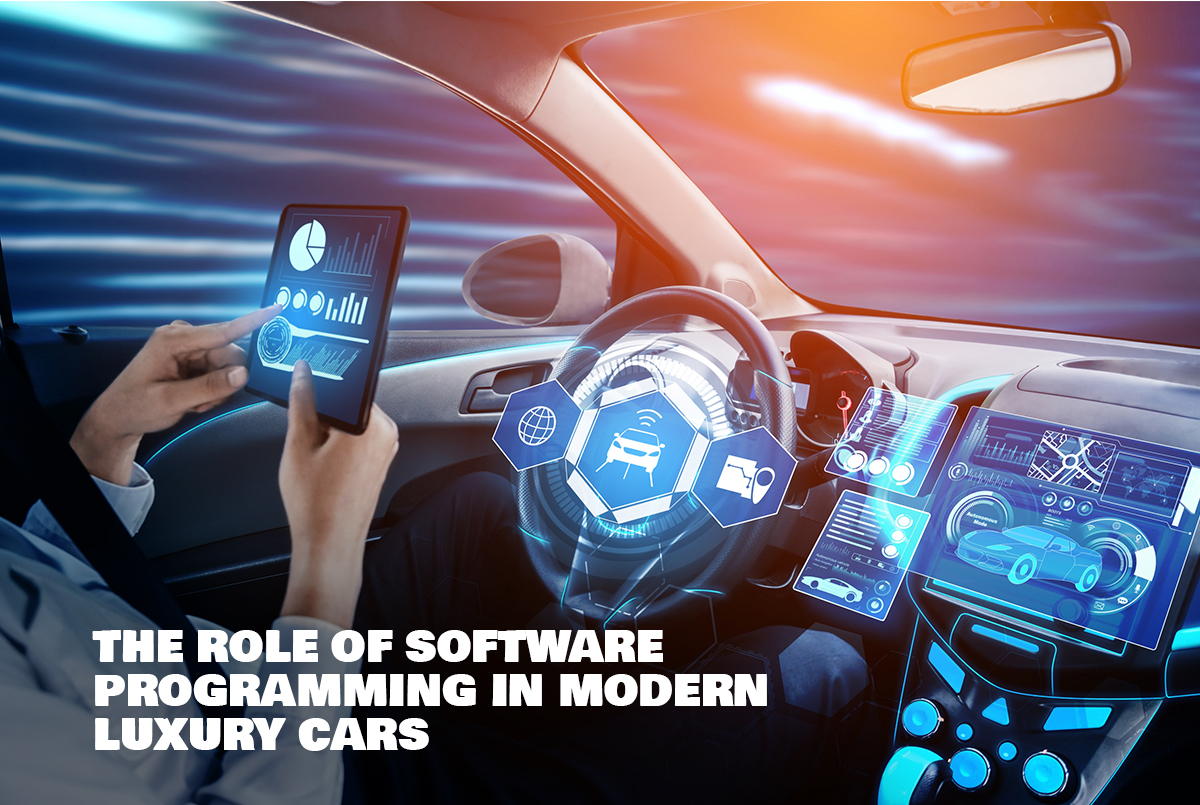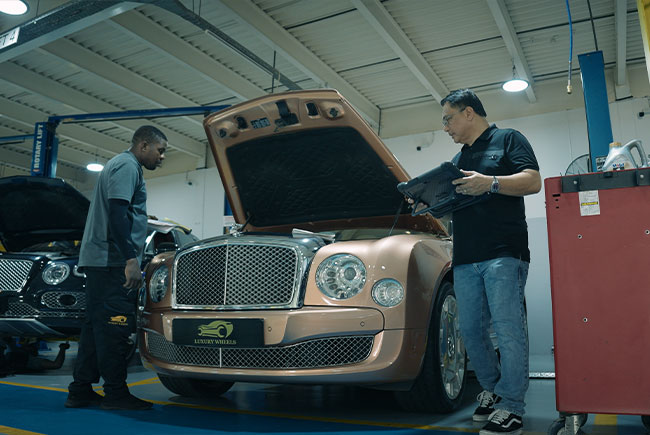
Table of Contents
- The Digital Heartbeat: How Software Redefines Core Performance
- Intelligence on Wheels: Advanced Driver Assistance and Autonomous Capabilities
- The Connected Cocoon: Luxury Cars as Digital Ecosystems
- The Unseen Architect: Automotive Software Development
- Empowering Ownership: Software Updates and Personalization
- The Future is Software-Defined: Innovations Shaping Tomorrow’s Luxury Cars
- Conclusion: Software as the Ultimate Luxury Differentiator
- FAQ
In the rarefied realm of luxury cars and trucks, elegance, comfort — even an aura of prestige — often are defined by assembly-line production not just in terms of materials and mechanics but in ever more profoundly subtle layers of software that govern virtually every vehicle function. Software programming in today’s luxury automobiles is the key to intuitive driving, smart help, automatic updates, and diagnostic smarts. Our identity as a Luxury car garage at Luxury Wheels has also changed in line with this: repairs, maintenance, and tuning are no longer just about spanners and screws – here at Luxury Wheels, they’re just as much about diagnostic tools, diagnostic software, engine calibration, system updates, and automotive software development.
From reading error codes through the OBD system and diagnostic scanners to reprogramming ECU modules or rolling out transmission software updates, service work on modern vehicles now requires advanced knowledge of software. Modern-day ADAS operates via millions of lines of code designed by software architects and implemented by software engineers. Here, we look at how the latest in software architecture defines what it means to sit behind the wheel of a contemporary luxury car across five key areas – performance, safety, connectivity, ownership, and the future.
The Digital Heartbeat: How Software Redefines Core Performance
Precision Engine Management & Power Delivery
The modern high‑performance engine is based on an Engine Control Unit (ECU) - a sophisticated controller whose operation is software-driven. By means of engine calibration, the ECU adjusts injection timing, not only boost levels, but more ignition curves and fueling strategies are continuously adjusted to have more power. They are not static maps in these current Engine management systems: the software will adjust for ambient conditions, fuel quality, driver input, and heat soak. That doesn't just translate to power and practical front-wheel and part-time all-wheel drive; it means smooth, refined delivery of torque as well as response.
Seamless Transmission Control
Luxury vehicles depend on complex transmission software to schedule shifts based on context. Whether in comfort, sport, or eco mode, logic reads throttle position, speed, road grade, and driver type to determine shift points. In high-end vehicles like a Mercedes-Benz S Class or Rolls‑Royce models, could the seamless and near undetectable act of gear changes be achieved by raw mechanical force alone (without sophisticated software)?
Adaptive Suspension & Dynamic Ride Comfort
Adaptive suspension systems are based on software that reads sensors — ride height sensors, accelerometers, yaw rate sensors — and adjusts damping and actuators in real time. The control systems can smooth the ride on bumpy roads or stiffen it for spirited driving. In reality, that means only supreme comfort one minute, confident dynamics the next, in a mode swap at the turn of a dial.
Integrated Electronics & Control Systems
What’s more, there’s another layer on top of the drivetrain and suspension: a contemporary luxury car is a mesh of ECUs that control lighting, steering assist, brakes, climate control systems, and infotainment functions, and lots else besides. These control systems have to play together – regenerative braking, stability control, and adaptive suspension need to collaborate efficiently under a single piece of software management. This is the seamless intelligence that makes premium possible.
Intelligence on Wheels: Advanced Driver Assistance and Autonomous Capabilities
Elevating Safety and Convenience with ADAS
Advanced drive assistance systems (ADAS), like adaptive cruise control, lane assist, parking sensors, and automatic braking, are found in most luxury cars nowadays. 3. Software: This takes data from cameras, radar, lidar, and ultrasonic sensors, and helps understand the surroundings. The logic calculates when to warn, intervene, or even take throttle and brake. In higher-end lines, the act must feel natural, fine-tuned, and anticipatory, not sudden.
The Road to Autonomy: Software’s Role in Self-Driving
Perception, Planning, and Control of Autonomous Vehicle. The world’s most advanced autonomous driving technology and self-driving car software, perception combines with planning, control, and safety within your driving architecture. Object detection, action classification, and scene segmentation often rely on edge-aware neural networks for perception tasks. The planning algorithms create paths, while the control modules control the steering wheel, throttle, and brake. V2V communication and more generally Internet of Things (IoT) connectivity can facilitate coordination and situation awareness. Top-level software needs to consider redundancy, fallback mode, and safety certifications.
The Connected Cocoon: Luxury Cars as Digital Ecosystems
Telematics, IoT, and Vehicle Communication
Luxury vehicles have become networked nodes in a digital web. Telematics modules send cloudward anonymized vehicle data, and vehicle communication apps allow owners to interface via remote diagnostics, status checks, and climate preconditioning. Utilizing IoT integration, a car can connect to smart homes, charging stations, and other devices, making it a digital companion.
Real-time Navigation and Infotainment Evolution
Real-time Navigation applications consume live traffic, incidents, road closures, and predictive routing. Infotainment systems operate software streaming, voice control, OTA media update, and apps. In the luxury space, these systems are seamlessly woven together – navigation, media, and vehicle condition all cross-talk without delay or discrepancy.
Integration into Smart City Initiatives
In smart city architectures, vehicles and infrastructures communicate thanks to V2I protocols. Traffic signs, parking automation, and urban sensors work together to free up congestion, optimize directions, and save energy. Luxury cars in such smart city integration become incorporated into a wider ecosystem, able to respond intelligently to changes in the environment using coordinated software.
The Unseen Architect: Automotive Software Development
The Scale of Code: From Millions to Billions of Lines
Today, a luxury car might contain tens of millions of lines of embedded code and dozens of ECUs. Throw in full autonomy, sensor fusion, connectivity, AI, and you’re talking potential code bases of billions of lines of code. This huge software estate is the work of each subsystem (drivetrain, safety, infotainment).
Crafting Excellence: Software Architects and Engineers
Under the hood, software architects are designing modules, doing dependency management, interface design, and scoping of module-system boundaries. The various parts are developed, tested, and tuned by the software engineers. The three of them work together to make sure that things can be maintained while remaining fast and safe. A brand such as Luxury Wheels Automobile depends on the best of staff in these areas to ensure perfect software integration.
Firmware and ECU Architectures: The Deep Dive
ECU run firmware with well-defined hierarchy: bootloaders, RTOS kernels, middleware, and application logic. ECU architectures are specified along standards such as AUTOSAR (classic and adaptive). The corresponding communication is realized by means of CAN, LIN, FlexRay, or Automotive Ethernet. Memory limitations, real-time scheduling, and redundancy requirements together make the design of such a system highly delicate.
Rigorous Testing and Advanced Diagnostics
Validation also comprises tests on components as unit tests, integration tests, MIL (model-in-the-loop), SIL (software-in-the-loop), and HIL (hardware-in-the-loop). In the shop, there are multiple indispensable diagnostic devices – advanced diagnostics, diagnostic equipment, car diagnostic scan tools, On-Board Diagnostics (OBD), and error code reading tools, among others. Dashboard warning lights, immobiliser systems, and OBD system gateways feedback information to drivers and websites such as Luxury Wheels Automobile and Luxury car garage teams using diagnostic software to localize faults or reprogram modules.
Empowering Ownership: Software Updates and Personalization
Continuous Improvement Through Over-the-Air (OTA) Updates
One of the key benefits of software-defined vehicles today is their ability to accept Over-the-air updates. These updates, software or system, allow updating patches remotely, including new features, upgrades, performance optimizations, and bug fixing without the need for a driver to head to the garage / on-the-road kitchen. OTA enables the car to be an upgradable platform.
Enhanced Security and Vehicle Integrity
The more connected we are, the greater the potential threat there is to cybersecurity. To secure the integrity of the vehicle, OEMs introduce measures such as secure boot mechanisms, encrypted messages, signature checks on software updates, and intrusion detection systems on partitioned network domains. These precautions also prevent unlawful manipulation and protect ECUs and vital systems from external attacks.
Personalized Driving Experience
Custom software is the new luxury. Vehicles can save driver profiles (seat location, climate, media preferences, and drive style) and adjust accordingly depending on who’s driving. It doesn’t just listen, it learns and recommends changes or reaches out to suggest you change modes—reminding you how any experience can be deeply personal.
Proactive Car Maintenance and Diagnostic Insights
Distributed software constantly analyzes the system and predicts when it will fail. Advanced diagnostics and OBD data can also further trigger alerts or pre-scheduled services (e.g., at Luxury Wheels). This model of car maintenance shortens downtimes, increases trustworthiness, and instills confidence in the car and its user.
The Future is Software-Defined: Innovations Shaping Tomorrow’s Luxury Cars
Artificial Intelligence and Predictive Capabilities
In the future, perception prediction and anomaly detection will be carried out by neural networks and AI models. Cars could predict mechanical wear, drive the way a driver feels, or fine-tune performance on-the-fly to reflect road conditions and stretch the limits of what premium mobility can provide.
New Features and Performance Upgrades Delivered via Software
Without the need for new hardware upgrades, these functionalities – such as advanced driving modes, upgraded visuals, and new ADAS features – can be pushed directly to vehicles through software updates and OTA Performance Upgrades. That way, luxury vehicles remain state-of-the-art for years after you've bought them!
The Evolving Relationship Between Vehicle and User
With time, the car will not just be a machine but something of a learning buddy. Car-communication apps are also merging with cellphones, residential systems, and municipal infrastructure. The car learns with the user’s habits and choices, driving further engagement and sophistication.
Conclusion: Software as the Ultimate Luxury Differentiator
The paradigm shift from hardware‑centric to software‑defined vehicles<
Especially in high-demand markets like Luxury car repair in Dubai, offering Luxury wheels paired with sustainable services sets your business apart. Clients seek trust, performance, and responsibility. By aligning your operations with modern expectations, your garage becomes not just a service provider but a pioneer in green innovation.
From the ECU with its engine calibration, to the transmission software, the adaptive suspension, the driver aids, and autonomous driving s/w, diagnostic s/w, or even OTA system updates— all key roles rely on sophisticated software. The specialisation in software diagnostics and control. Even the Bentley specialisation Luxury Wheels, a Luxury car garage, started after seeing it done by one of their competitors.
From the ECU with its engine calibration, to the transmission software, the adaptive suspension, the driver aids, and autonomous driving s/w, diagnostic s/w, or even OTA system updates— all key roles rely on sophisticated software. The specialisation in software diagnostics and control. Even the Bentley specialisation Luxury Wheels, a Luxury car garage, started after seeing it done by one of their competitors.
Emphasizing ongoing innovation and the future of automotive luxury
As computer scientists and systems designers get more creative, the cars of tomorrow will be smarter, nimbler, and more coordinated. Using AI, predictive systems, and OTA upgrades as well as deep connectivity, I believe the future of automotive luxury is software first.”
Book Your Service Today
Frequently Asked Questions

What role does software programming play in the functionality of modern luxury cars?
Software programming is fundamental — it controls engine movement, both online and offline (engine position when the battery is charged and when it’s not), gearbox, suspension, safety systems like airbags, infotainment diagnostics, and connectivity. Minus advanced coding, a contemporary luxury vehicle wouldn’t be smooth, automated, or smart enough.
How does software programming enhance the performance and features of luxury vehicles?
Software elevates performance, comfort, and feature sets through engine calibration, adaptive control, OTA performance upgrades, and integrated subsystems. It’s what allows adaptive cruise, lane assist, buttery gear changes, and that real-time change depending on a given road or driver.
What is the relationship between software programming and automotive safety features?
Safety systems -- automated braking, ADAS (advanced driver assistance), collision avoidance – are highly software-oriented. They’re meshed with sensor input; they calculate risk and react within milliseconds. The software provides redundancy, smooth operations, and redundant fail-safe features that you would expect from a premium vehicle.
How do software updates impact the performance and usability of luxury cars?
OTA software updates allow manufacturers to issue refinements, new features, calibration tweaks, and security patches remotely. This maintains performance, squashes bugs, and improves the driving experience over the life of the vehicle.
How is software cybersecurity maintained in modern luxury vehicles?
Security comes with secure boot, encrypted communication, update signature validation, network segmentation, intrusion detection, access control,... and frequent patching. They guard against unauthorised access to the ECUs or data paths.
How do manufacturers implement software programming for autonomous driving in luxury cars?
They build layered stacks: perception (neural nets), planning, control, safety fallbacks, V2V/V2I comms, redundancy and failover. Extensive simulation, real-world validation and modular software architecture by software engineers and software architects guarantee reliability and safety.
What programming languages and frameworks are most commonly used in luxury car software development?
Safety-critical modules often use C or C++ (compliant with MISRA standards). Higher-level logic may use Python, Java, or embedded frameworks. Neural network components often derive from TensorFlow or PyTorch and are compiled into optimized inference engines. Middleware architectures—such as AUTOSAR Classic or adaptive—and real-time operating systems are standard in the domain.

